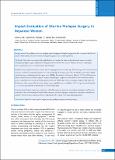Please use this identifier to cite or link to this item:
https://hdl.handle.net/20.500.14356/1931Full metadata record
| DC Field | Value | Language |
|---|---|---|
| dc.contributor.author | Chhetry, D B | - |
| dc.contributor.author | Upreti, S R | - |
| dc.contributor.author | Dangal, G | - |
| dc.contributor.author | Subedi, P K | - |
| dc.contributor.author | Khanal, M N | - |
| dc.date.accessioned | 2023-06-02T04:36:20Z | - |
| dc.date.available | 2023-06-02T04:36:20Z | - |
| dc.date.issued | 2012 | - |
| dc.identifier.citation | ChhetryD. B., UpretiS. R., DangalG., SubediP. K., & KhanalM. N. (2012). Impact Evaluation of Uterine Prolapse Surgery in Nepalese Women. Journal of Nepal Health Research Council. https://doi.org/10.33314/jnhrc.v0i0.325 | en_US |
| dc.identifier.issn | Print ISSN: 1727-5482; Online ISSN: 1999-6217 | - |
| dc.identifier.uri | http://103.69.126.140:8080/handle/20.500.14356/1931 | - |
| dc.description | Original Article | en_US |
| dc.description.abstract | Abstract Background: The problem of uterine prolapse exists throughout Nepal and negatively affects women’s health and quality of life (QOL). The Government of Nepal recognizes it as a priority problem. Methods: This study was conducted in eight districts to examine the status and problems of women who have undergone prolapse surgery. Qualitative and quantitative methods were used to examine the issues of prolapse. Survey method was used to administer the questionnaire. Results: Sixty-six percent women reported pelvic organ prolapse at an early age. The mean age of its occurrence was 28 years. In the hill/mountain districts, 52% women among the non-poor and 72% among the poor went to health camps for surgery indicating that the camps were fulfilling the demands of the poor. Majority (>75%) of them from remote districts went to health camps for surgery indicating the camps were more beneficial to women in remote areas. Counseling was weak in the health camps and the use of IEC materials was minimal. Majority had improved health status after surgery. The incidence of post-surgery problems were as follows: 10.1% in government hospitals, 11.1% in non-government hospitals and 15.1% in health camps. Conclusions: Despite improved performance of health camps, the program for prolapse management still seems weak due to lack of ownership of local health institutions and lack of proper coordination among the stakeholders/ partners. However, these camps need to be scaled up for the benefit of the unreached population. Keywords: Nepalese women; pelvic organ prolapse; prolapse surgery; uterine prolapse. | en_US |
| dc.language.iso | en | en_US |
| dc.publisher | Nepal Health Research Council | en_US |
| dc.relation.ispartofseries | May-Aug, 2012;325 | - |
| dc.subject | Nepalese women | en_US |
| dc.subject | Pelvic organ prolapse | en_US |
| dc.subject | Prolapse surgery | en_US |
| dc.subject | Uterine prolapse | en_US |
| dc.title | Impact Evaluation of Uterine Prolapse Surgery in Nepalese Women | en_US |
| dc.type | Journal Article | en_US |
| local.journal.category | Original Article | - |
| Appears in Collections: | Vol 10 No 2 Issue 21 May - Aug, 2012 | |
Files in This Item:
| File | Description | Size | Format | |
|---|---|---|---|---|
| 325-Article Text-324-1-10-20130823.pdf | Fulltext Download | 593.61 kB | Adobe PDF |  View/Open |
Items in DSpace are protected by copyright, with all rights reserved, unless otherwise indicated.
